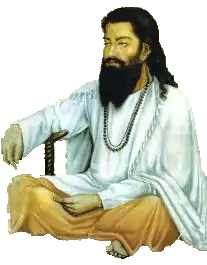Ad-Dharmi
The Ad-Dharmi is a Dalit Scheduled Caste of Agriculture workers origin mainly found in the state of Punjab in India.[1] As of today, they are entitled to reservations in Education sector and government jobs, as they are recognised as a Scheduled Caste.[2] Ad Dharmis are 14.9% of the total Dalit population in Punjab.[3]
| Part of a series on the |
| Ravidas Panth |
|---|
 |
| Beliefs and practices |
| Temples |
| Scriptures |
| Holy Places |
| Founder |
| Sants |
| Festivals |
| Symbols |
 |
Origin
The Ad-Dharm movement was started in 1920s, for the purpose of getting a distinct religious identity same as Adi Dravida movement of Tamil Nadu. The founder of the Ad-Dharm Movement was Mangu Ram Mugowalia (founding member of Ghadar Party), Master Gurbanta Singh (senior Congress leader) B. L. Gherra and also Pandit Hari Ram (Pandori Bibi) who was the secretary of the organization.[4]
The movement projected Ravidas, the 13th century Bhakti Movement saint as their spiritual Guru and a sacred book Ad Parkash for separate ritual traditions. The Ad-Dharmi Dalits came together as a faith was in 1925 when the British ruled India.
In the 1931 census, more than 450,000 registered themselves as members of the new indigenous faith called Ad Dharam (or Original Religion).[5] But this faith and movement vanished after India's independence because of major concentration of its leader into state politics and govt.'s reservation policy only for low-caste from Hindu, Sikh and Buddhist communities.[6]
Clans of Ad Dharmis include - Badhan, Bains, Batoi, Bhatti, Ghamori, Heer, Kathana, Mehmi, Phundwal, Sidhu, Chauhan, Bangar, Kajla, Chumber and Kaler.[7]
Present circumstances
Although the Ad-Dharmi are followers of Guru Ravidas (now Ravidassia religion),[8] and incorporate elements of Sikhism[9] as they regard Shri Guru Granth Sahib as their religious text.[10] But after killing of Ramananda Dass on Vienaa triggered them a lot and they formed separate Amritbani and customs.[11]
Each of their settlement contains a gurdwaras and Ravidas Bhawans, which are both a centre of worship and as well as a focus of the community.
The traditional occupation of the Ad-Dharmis was leather tanning and also a majority were involved in peasantry. Many Ad-Dharmis have started to migrate to towns and cities, for better opportunities. As other Punjabi communities, the Ad-Dharmis have participated in the overseas migration of the ethnic group. There are now fairly large no. of Ad-Dharmis in Europe and North America, in particular the United Kingdom.[12]
Notable Ad Dharmis
- Mangu Ram Mugowalia, founding member of Ghadar Movement and Ad Dharm movement in Punjab[13]
See also
References
- "Deras and Dalit Consciousness". Mainstream Weekly. 13 June 2009. Retrieved 6 January 2016.
- "Scheduled Caste Welfare - List of Scheduled Castes" (PDF).
- "PUNJAB DATA HIGHLIGHTS : THE SCHEDULED CASTES" (PDF).
- pg 20, Sikh Identity: An Exploration Of Groups Among Sikhs by Opinderjit Kaur Takhar
- "India's 'untouchables' declare own religion". CNN.com. Retrieved 6 January 2016.
- Gill, Manmohan Singh (December 2, 2015). "Punjab Society". Google Books. Retrieved January 6, 2016.
- A Glossary of the Tribes and Castes of the Punjab and North-West Frontier Province: A.-K. Atlantic Publishers & Dist. 1997. ISBN 978-81-85297-69-9.
- "Mention Ravidasia as religion: Dera Sachkhand to followers". Indian Express. Retrieved 6 January 2016.
- "Like the other Sikh gurudwaras, Ad-Dharmis too keep the Guru Granth Sahib at their Ravidas Gurudwaras- Caste in Question". Google Books. December 2, 2015. Retrieved January 6, 2016.
- Singh, IP (4 February 2010). "Ravidassia leaders reject new religion". The Times of India. Retrieved 6 January 2016.
- "The strong differences within the Adi-dharmi/ Ravidassia community have taken another twist with a Phagwara-based century-and-a-half-old Dera of the community moving Punjab and Haryana High Court alleging that Dera Ballan indulged in plagiarism in preparing "Amrit Bani Satguru Guru Ravidass" Granth as it announced founding of a separate religion - Ravidassia- over three years back. - Times of India". The Times of India. Retrieved 2020-05-21.
- People of India Punjab Volume XXXVII edited by I.J.S Bansal and Swaran Singh pages 20 to 25 Manohar
- Teltumbde, Anand (2016-08-19). Dalits: Past, present and future. Taylor & Francis. ISBN 978-1-315-52644-7.